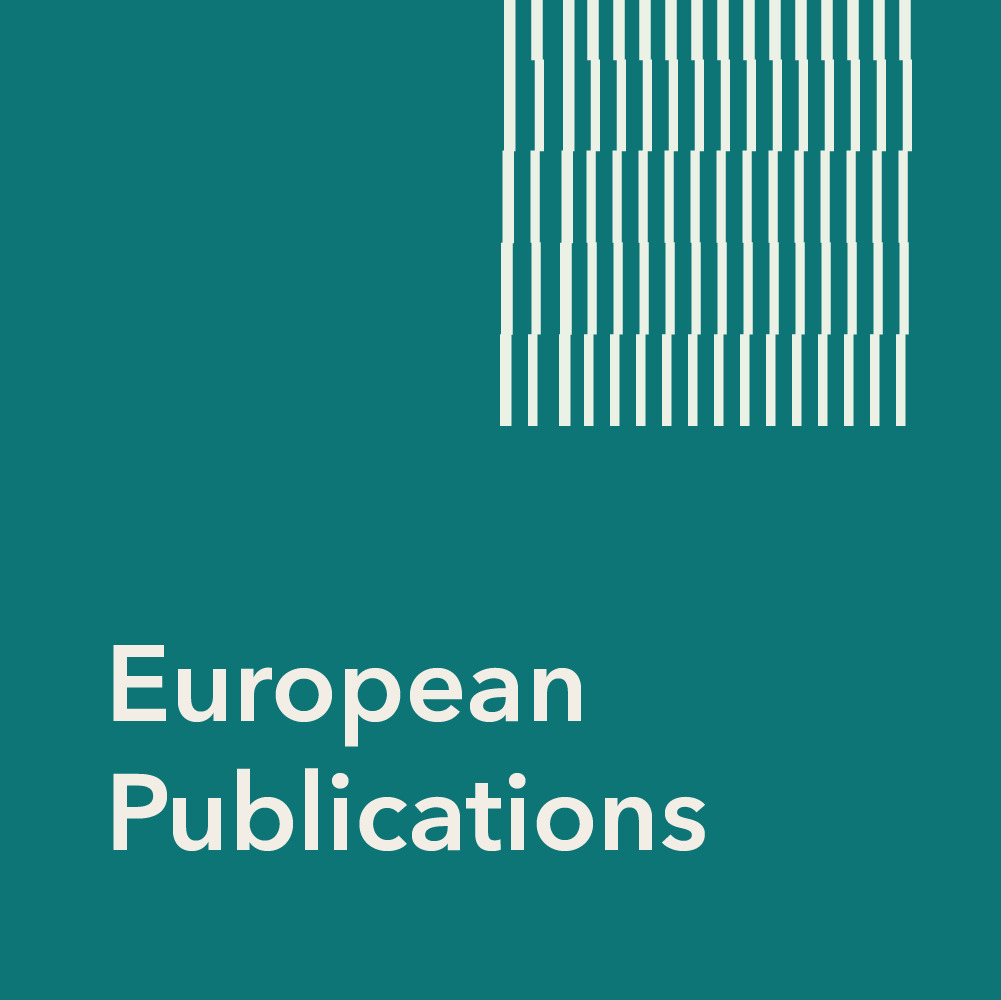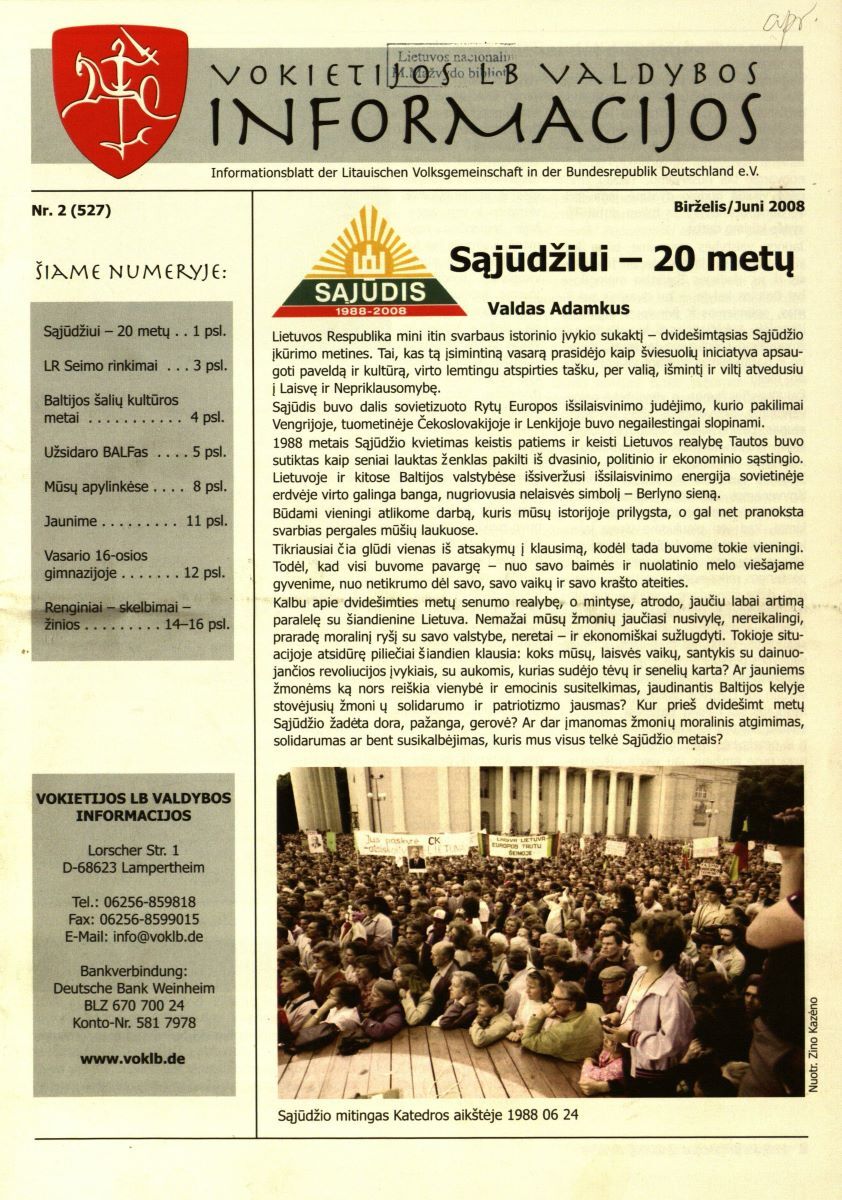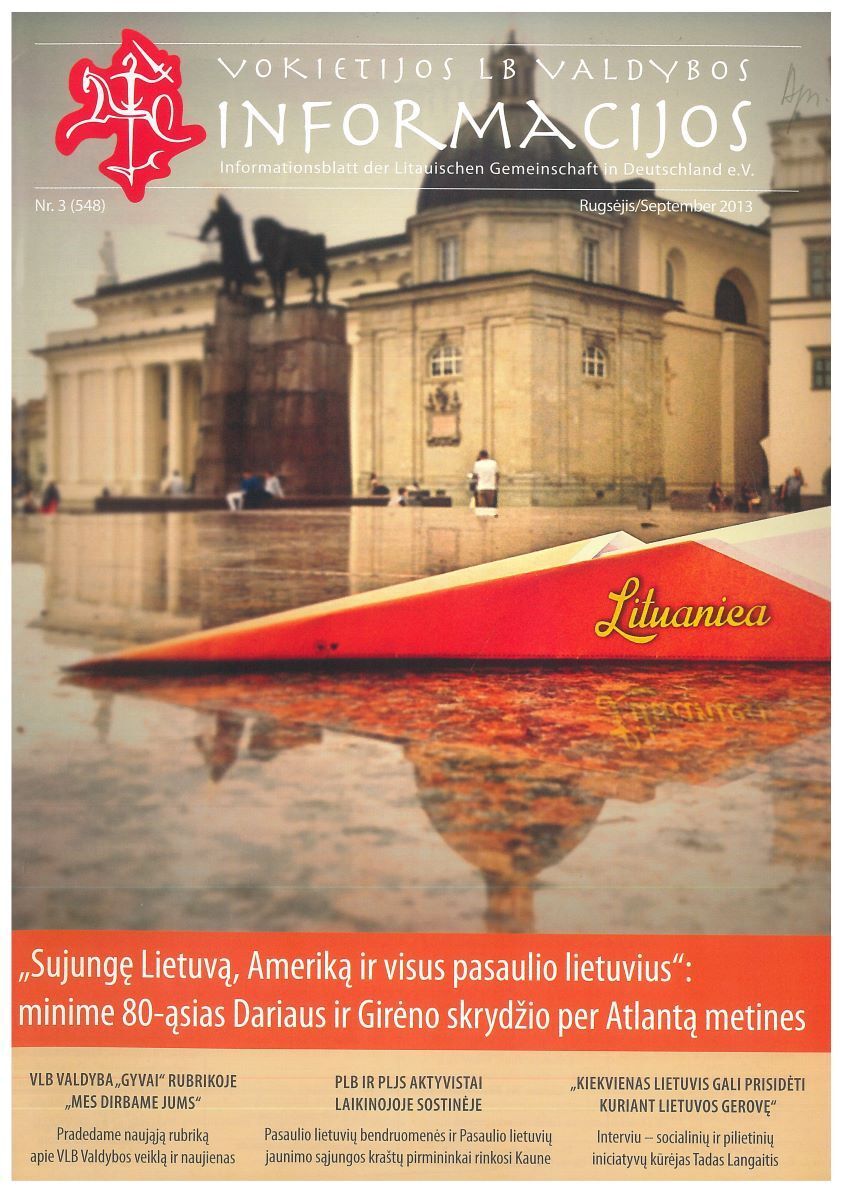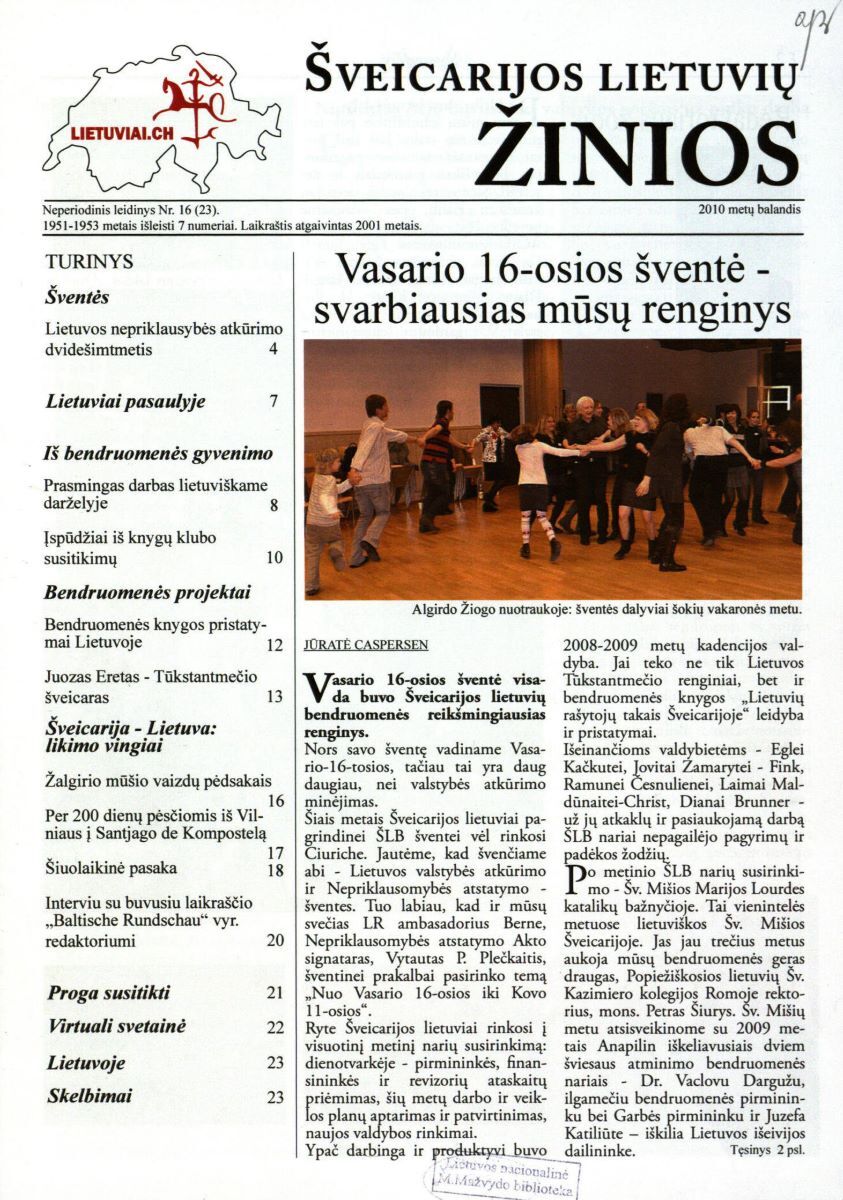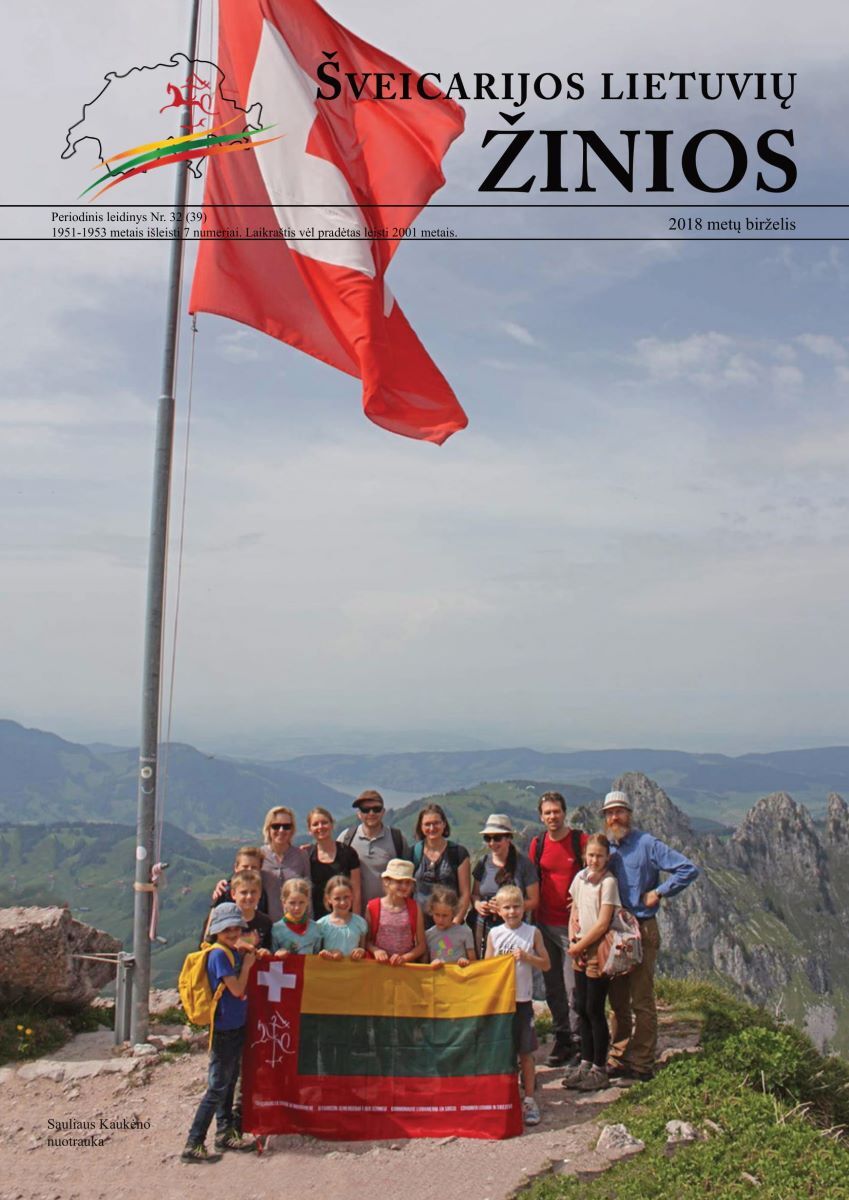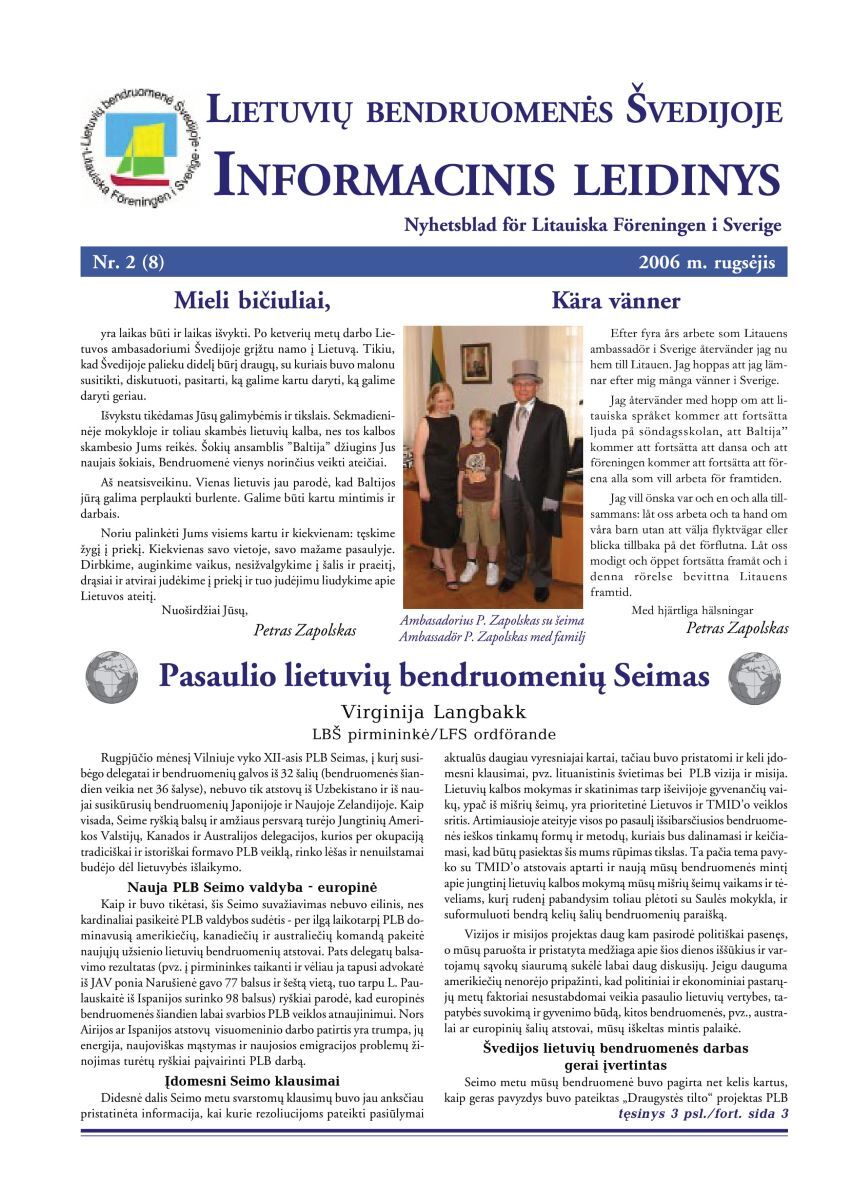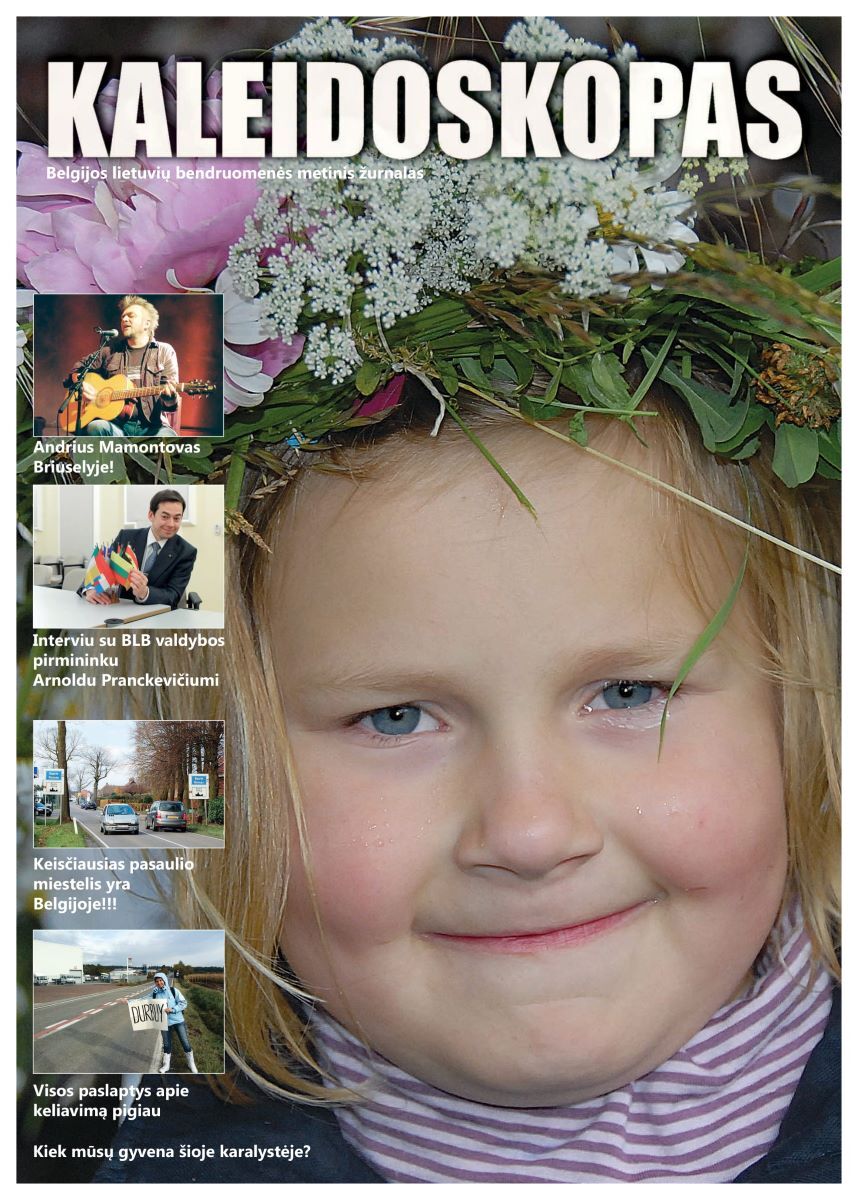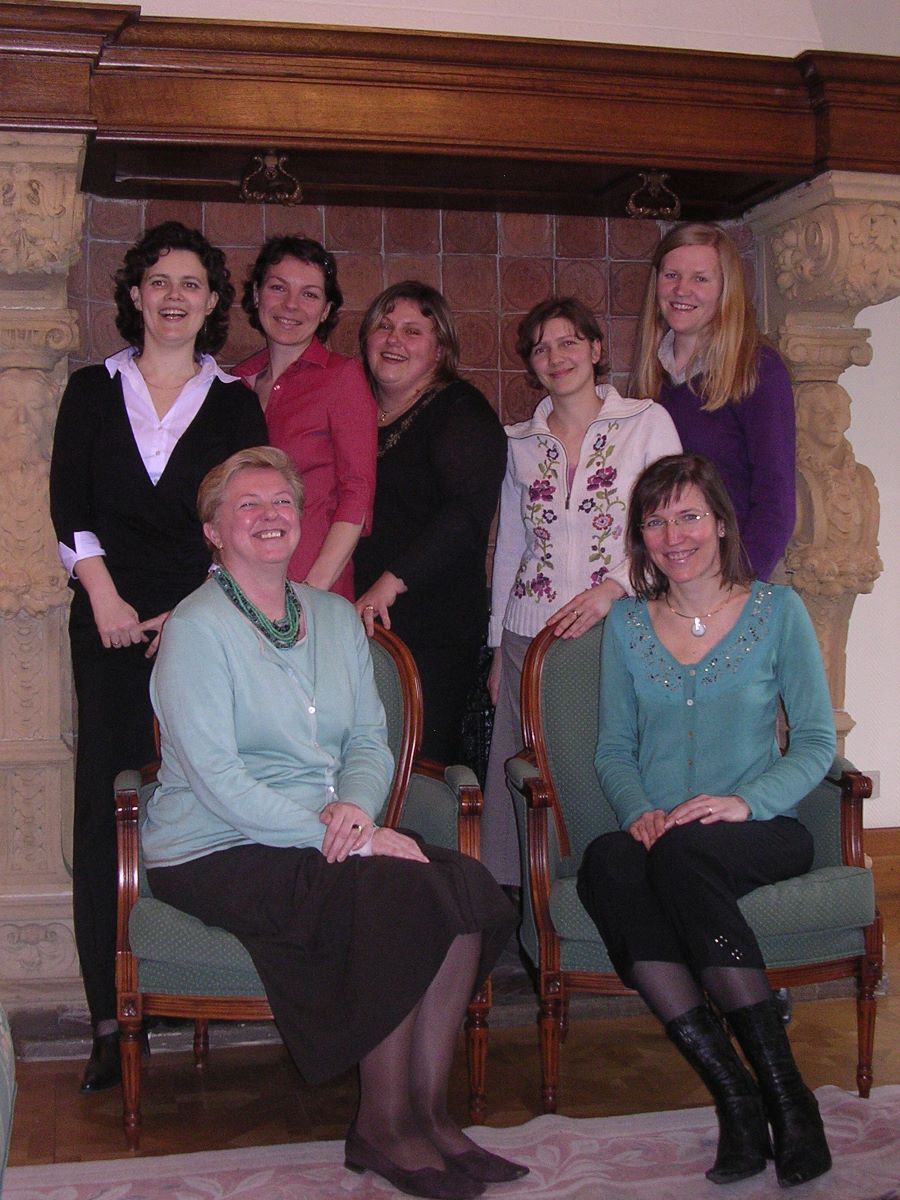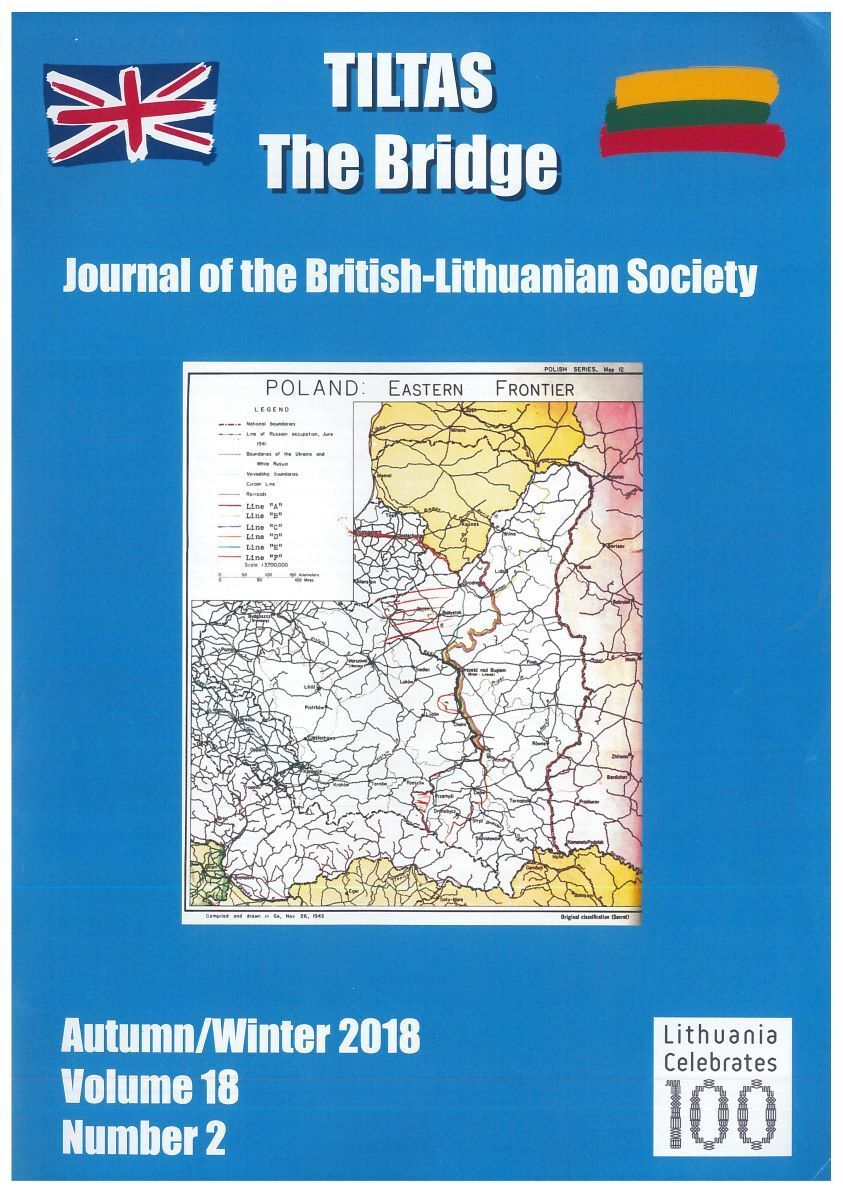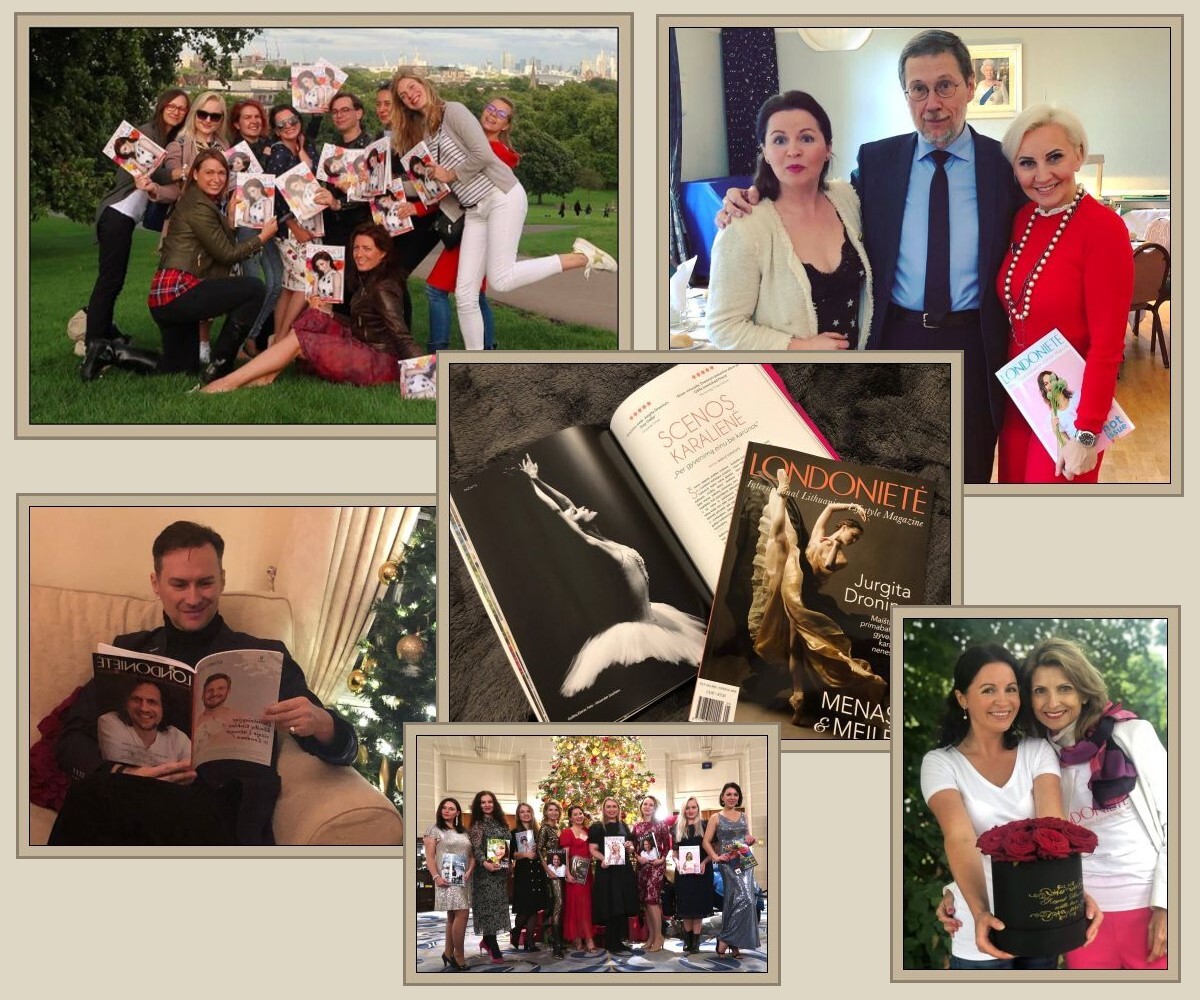-
-
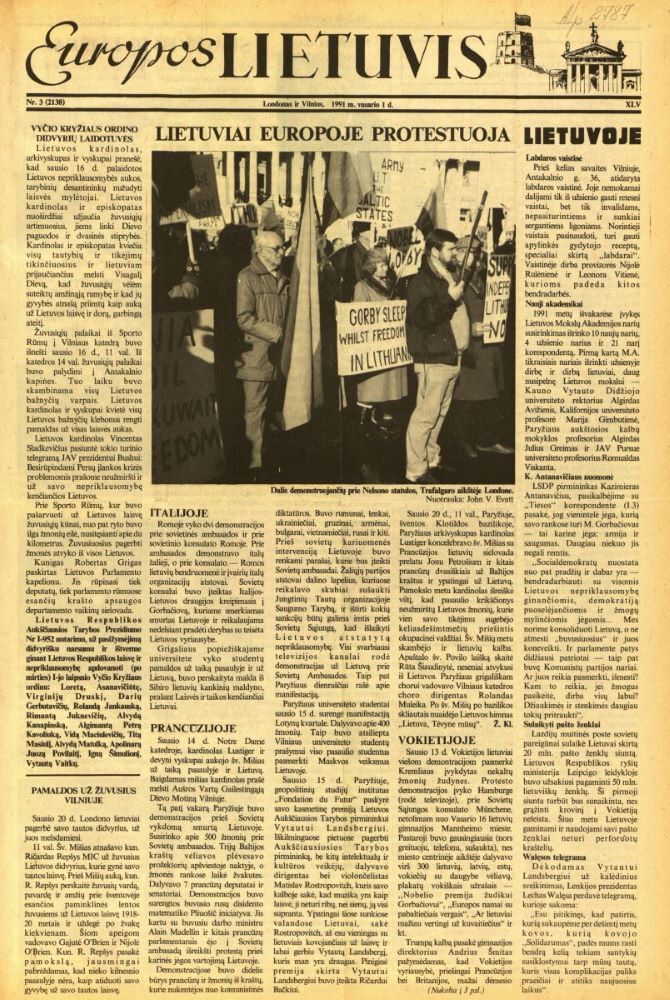
Front page of The European Lithuanian, No. 3, February 1, 1991
The European Lithuanian
Europos lietuvis
The European Lithuanian had a dynamic history. Great Britain’s Lithuanian newspaper was published from 1947 to 2013. Issues 1 to 13 were named The Internal and Foreign News Bulletin (1947 to 1952) and from 2010 to 2013 it was The British Lithuanian; from 1952 to 1953 it was The European Lithuanian Newspaper and from 1953 to 2010 – The European Lithuanian.
The Lithuanian Association of Great Britain published the newspaper until 1992, together with Lietuvių namai (Lithuanian House) Corporation from 1954 onward. In January of 1991, editor Vladas Dargis had it published in Vilnius, where it was printed continuously starting in 1992. The board of publishers decided to bring it back to Great Britain in 1996, where it was once again published by the Lithuanian Association of Great Britain and Lietuvių namai (Lithuanian House) corporation. Members of the editorial board are Mečys Bajorinas, Mečys Šilkaitis, Bronius Daunoras, Kazimieras Barėnas, Juozas Lūža, Vladas Dargis, Henrikas Gasperas, Ilma Švalkienė and others.
From its inception, the newspaper was meant not only for Lithuanians in Great Britain, but all of Europe. On September 24, 1953, the publication described itself as being symbolic of the efforts of Lithuanian communities throughout Europe to join forces and work together for Lithuania and the retention of Lithuanian culture. During publication in Lithuania, it concentrated on Lithuanian political news, human rights, and the analysis of the process leading up to the restoration of independence. It was thought that being there, the newspaper would be better equipped to inform Lithuanians in the diaspora about changes taking place in Lithuania, bringing all the diaspora news media under one roof in the homeland. However in 1996, the editorial board realized that due to financial constraints and declining readership, the board of the Lithuanian Association of Great Britain must take the publication back to Great Britain. Since then its content focused chiefly on Lithuanians in Great Britain, with news about current events in Lithuania. Circulation decreased steadily: from 5,000 in 1992, to 1,700 in 1995, then 400 in 2003.
In 2009, in the final, 12th issue of the year, The European Lithuanian ended its 62-year lifespan, with the explanation that reading habits had changed and current technology had lured readers away from the printed word. With readership in decline, the publishers decided to discontinue printing to make way for new forms of communication. The final issue announced the arrival of a “refreshed and rejuvenated” British Lithuanian in 2010. The renewed publication lasted until 2013.
Europos lietuvis – The European Lithuanian in the portal epaveldas.lt (1961-2009). -
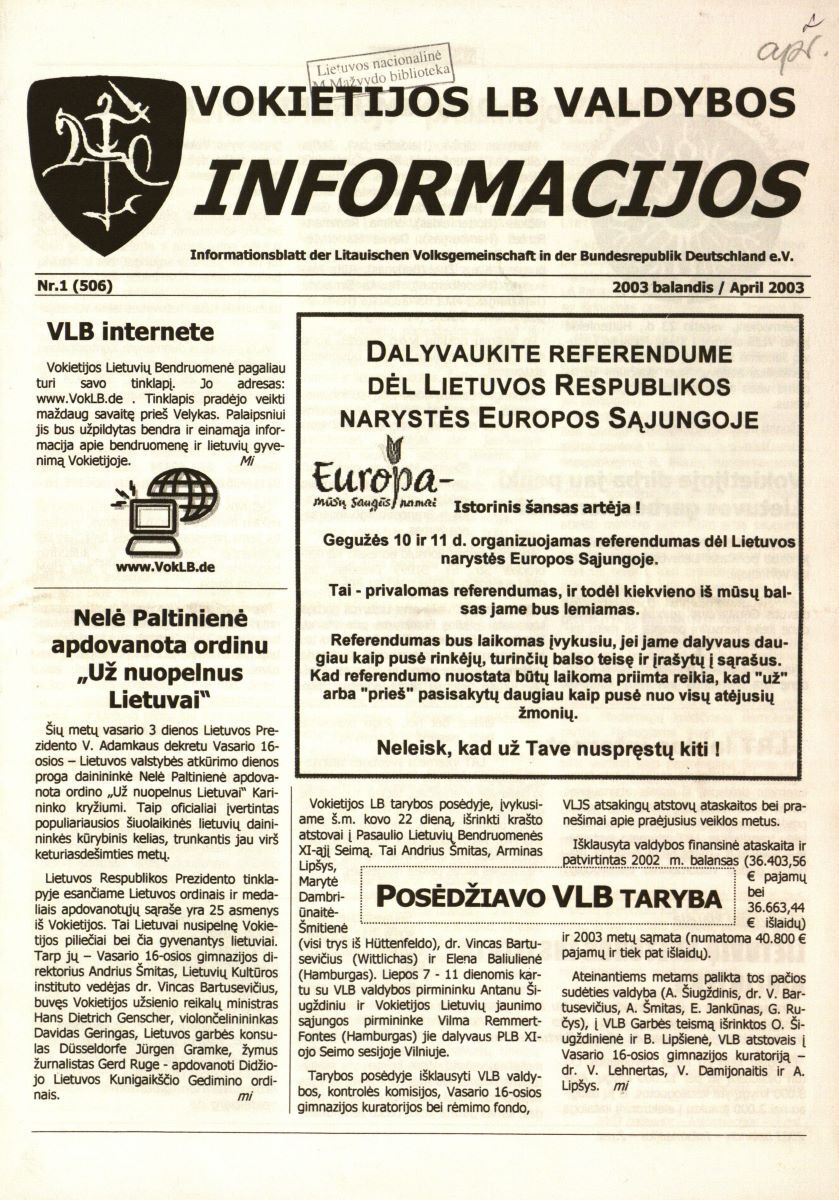
Front page of News No. 1, April 2003
German-Lithuanian Community News
Informacijos
The German-Lithuanian Community News magazine was established in the post-WWI era, and was unique in several ways. It is the only periodical published continuously for nearly 70 years, and the only publication in Lithuanian in Germany today.
The first issue, printed in April of 1951, was called WLC (World Lithuanian Community)-German Lithuanian Community Board News. At that time, the publishers noted that there was a lack of information about Lithuanian refugees Germany in many Lithuanian-language newspapers. To provide that information, the board decided to publish a monthly bulletin. The publication fulfills the same purpose today – to chronicle the daily lives of Lithuanians in Germany. Its self-proclaimed mission is to create and preserve the history of Lithuanians in the diaspora.The publishers succeeded in reaching not only other Lithuanian newspapers but communities and individuals throughout the world. From 1990-1991 it was printed irregularly. Since 1993 it came out every three months, and since 2017 there are 10 issues per year. In 2017 the News was moved to the internet. Editor-in-chief Evelina Kislych-Šochienė remembers that community members were encouraged to read the magazine online as it would be available to them at any time, but the problem was that its initiators were not keen to use the new platform. Older Lithuanians did not find it convenient to read on their telephones or computers. In 2019, with financial support from the Press, Radio and Television Fund, both electronic and print versions became available. Issues dating back to 2013 are now available on the website. The News had various editors, with Justinas Lukošius having the longest tenure, from 1968 to 1994. Agnė Ručytė was also a long-term editor. Since July, 2017, the editor-in-chief is E. Kislych-Šochienė and the designer is Elinas Venckus.
Naturally, during its first decades, content concentrated on life in displaced persons camps, the first Lithuanian schools and new organizations. Since 1990, the News covers important events in German-Lithuanian life, youth and smaller community associations, as well as Lithuanian language school activities. Many articles focus on art and culture, with features on various German Lithuanians. Coverage of current events and education are very important to readers today. The history of the News is the history of the German Lithuanian Community, renewing itself in step with the changing age and interests of its members.News on the website epaveldas.lt (1951-2010).
News on the German-Lithuanian website (since 2013).More about News in this interview with E. Kislych-Šochienė (in Lithuanian).
-
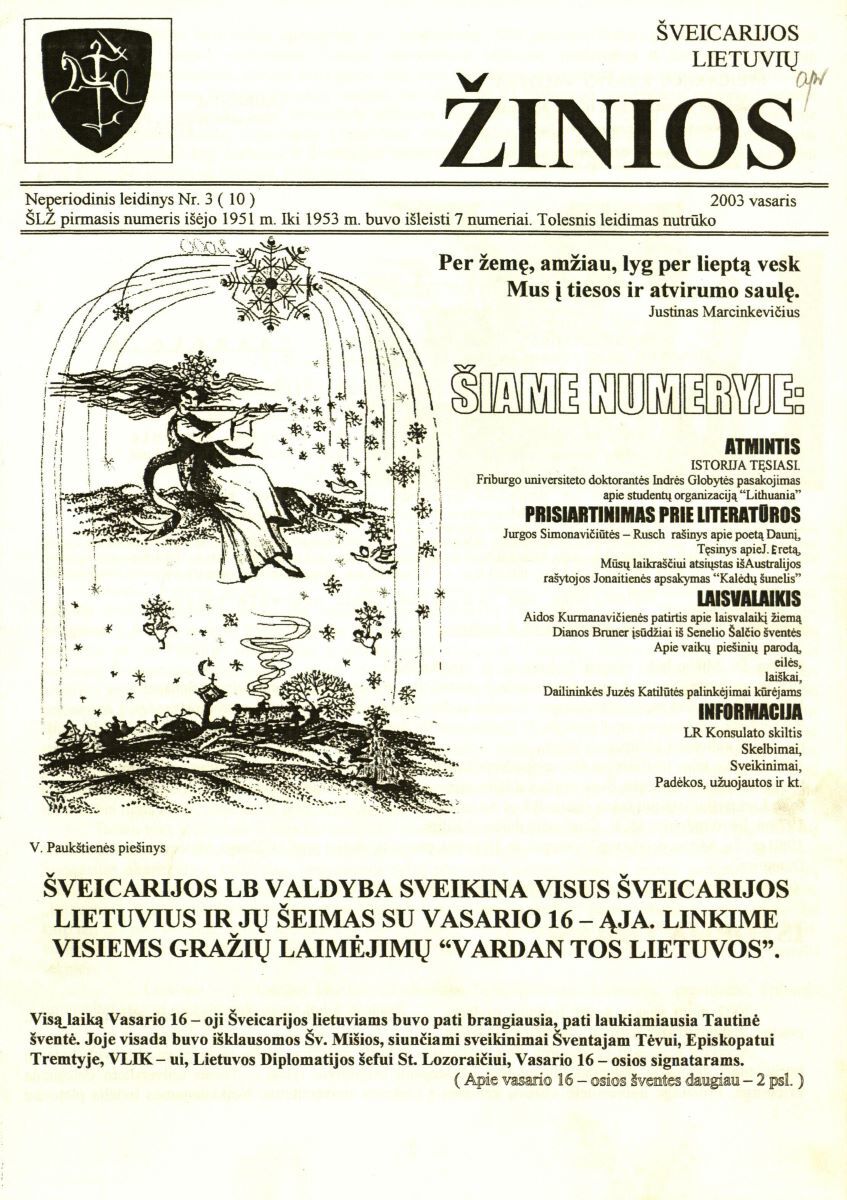
Front page, Swiss Lithuanian News, No. 3, February, 2003
Swiss Lithuanian News
Šveicarijos lietuvių žinios
The Swiss Lithuanian News was published from 1951 to 1953, and then again beginning in 2001. In 1951 the newspaper announced that the Swiss Lithuanian Community Board decided to publish the News as necessary (irregularly) and would reach every Lithuanian living in Switzerland. “We are children of the same Fatherland, Lithuania. We speak the same language and we are united in one Lithuanian Community.” In 1952 and 1953 the circulation was 150. Two years later, after seven issues, the publishers concluded in a final two-page issue that their resources could no longer support its publication.
In 2001 the publication was resurrected at the annual meeting of the Swiss Lithuanian Community. The first issue unveiled modest goals, however its scope was quite wide. The editorial staff invited opinions, comments, articles, photos and artwork. This was a publication by and for the third wave of Lithuanians, for whom the struggle for freedom as well as political and charitable topics were replaced by settlement issues, tracing earlier Lithuanian immigrants, the pursuit of careers, literary events and other interests. Until 2018 it appeared twice a year, non-periodically, with a circulation of 250. In 2019 it became a yearly, with coverage of the same topics: anniversaries, Swiss Lithuanian Community events, life outside the community, features on various Swiss Lithuanians, news from Lithuanian embassies in Switzerland, historical and current ties between Lithuania and Switzerland.
The 2011 anniversary issue revealed that the problems encountered by the founders were the same for the contemporary publishers, with few writers, and the burden of work carried out by the same people every year. The publishers took comfort in the fact that the original founders would have been proud to see the publication meet at least two anniversaries.
In 2010 the Swiss Lithuanian Community Board decided to digitize every issue since 1951, when it was typed on a typewriter, until today, when it may be read on the internet. The editorial board consists of Jūratė Caspersen, Janina Vaitkevičienė, Jurga Simonavičiūtė-Ruesch, Laima Maldunaitė-Christ, Diana Brunner, Ilona Katkienė, Lijana Tagmann and others.
Swiss Lithuanian News is available on the portal epaveldas.lt (1951-2010), and on the website of the Swiss Lithuanian Community (1950 to 2019). -
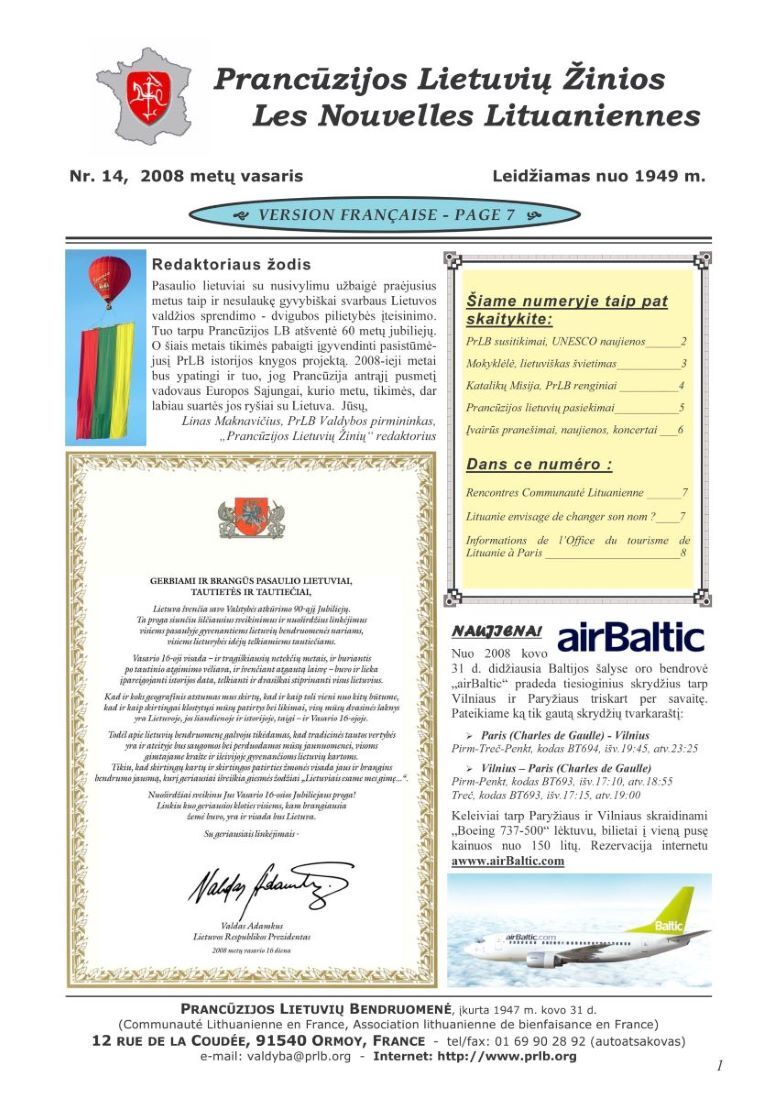
Front page, French Lithuanian News, No. 14, February, 2008
French Lithuanian News
Prancūzijos lietuvių žinios
Beginning in 1949, the French Lithuanian Community published a Lithuanian-language bulletin non-periodically. From 1954 m. it was published two to four times per year, and was called the French Lithuanian News, and continued until 1972. During the post-war period, it featured articles on Lithuania’s occupation, political and cultural life in France, as well as issues concerning the French Lithuanian community. Contributors were well-known intellectuals and cultural figures such as Algirdas Julius Greimas, Stasys Lozoraitis, and Rev. Audrys Juozas Bačkis. Long-term editors were Ugnė Karvelis, Ričardas Bačkis, and Antanas Liutkus.
The publication was revived in 2000, resuming its numeration, and printing texts in both Lithuanian and French. Community members were encouraged to contribute ideas, articles and commentary. In the second issue, published in November, the readers were reminded that the content was a reflection of their preferences, according to their requests and comments, with articles about both past and present. And because “everything new is but a revisitation of the past”, the name of the publication was also reinstated. The bulletin was delivered by mail to community members twice a year from 2002 to 2005, and once a year from 2006 to 2008. Topics included Lithuanian current events, Lithuanian language school classes, Lithuanian cultural events. The publication connected several generations of Lithuanians. In addition to current events, it featured interviews with post-war immigrants, high-profile Lithuanians in France, and those who arrived after 1990. The editor at the time was the Community board president Linas Maknavičius. Print publication was superseded by digital technology. Since 2014, community information is available on its website. -

Front page of the British Lithuanian Voice, No. 8, August, 2003
British Lithuanian Voice
Britanijos lietuvių balsas
A monthly non-partisan publication called the British Lithuanian Voice was published in Great Britain from 1999 to 2006 by the Lithuanian Cultural Club. The editor was Klemensas Tamošiūnas, the administrator – Juozas Levinskas. After the annual meeting of the members of the Lithuanian Association of Great Britain, the publishers recognized a void, and the necessity for a forum for constructive opposition. Then cultural activists took up the idea of a new publication allowing anyone who opposed the status quo to express themselves, as outlined in the first issue. It was a vehicle for positive, truthful, opinion within an ethical journalistic framework. The newspaper also promised content on Lithuanian authors and their work.
The newspaper’s motto was: “Want to know? Read the British Lithuanian Voice!” It covered a wide range of topics, such as Lithuanian history, post-war freedom efforts, the Soviet occupation, deportations to Siberia, the events of January 13. Much of the content focused on the daily life of Lithuanians in Great Britain, events and activities in the GB Lithuanian Association. Profiles of authors Jonas Biliūnas, Jonas Avyžius, Vladas Šlaitas, Vincas Kudirka and other authors as well as excerpts of their work was delivered as promised. World news and current events in Lithuania were also the subjects of regular reports.
The editorial staff invited everyone to contribute, to send requests regarding topics they wished to read about. The cost of the newspaper changed: annual subscription in Great Britain was £15, £20 in Europe. In November, 2005, subscription fees rose to £20 in Great Britain, £25 in Europe. Donations from individuals and various institutions were notsufficient to sustain it, and publication stopped in 2006, following the 10th issue of the year.
British Lithuanian Voice is available on the portal epaveldas.lt (1999-2006). -
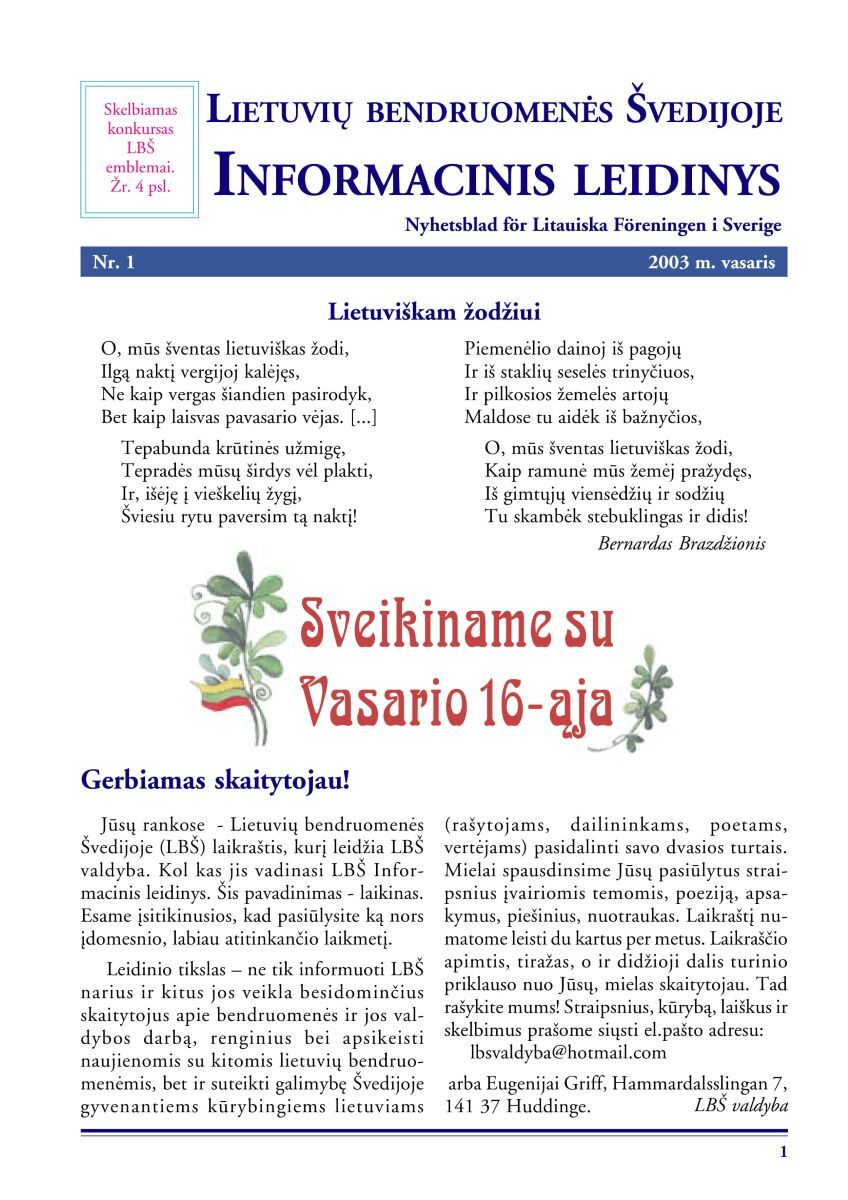
Front page of the Swedish Lithuanian Community News, No. 1, February 2003
Swedish Lithuanian Community News
Lietuvių bendruomenės Švedijoje informacinis leidinys
The newspaper’s primary goals were the retention of Lithuanian culture and identity, and promotion of the community’s activities in Sweden. It contained reports on various groups, Lithuanian language schools, community history, news from the Lithuanian Embassy in Sweden and the World Lithuanian Community. Also featured were books by Lithuanian authors translated into Swedish, as well as historical topics, interviews with members of the older generation starting in 2005, and active members of the community (in a column called “Let’s Meet”, begun in 2006).
The Swedish Lithuanian Community board and editor Audronė Vodzinskaitė-Städje were in charge of planning and content. Long-time board member Eglė Marcinkevičiūtė and later Eugenija Griff were responsible for publishing the newspaper. The guiding principle was – the more authors, the more interesting the newspaper. At first community members were reluctant to write, but gradually, more of them, especially the older generation, became willing contributors. As a result, the newspaper received a wide range of articles, photos and illustrations, including material by academics, cultural figures and activists in Lithuania, notably Ilona Lilieholm, Sigutė Radzevičienė, Giedrė Denneport, Jūratė Kaminskaitė, Ramunė Muralienė, Vaida Gudaitytė, Jurgita Baltrušaitytė, Diana Molero, Virginija Karrenbauer, Lina Varhos and others.
The publication was key in promoting the activities of the Swedish Lithuanian Community. Since 2006, a summary of the content has been added in Swedish, attracting more readers and more Swedish-speakers to the Community and the newspaper. It grew from 4 pages to 16, and the circulation increased from 100 to several hundreds. In its first year the publication was funded by the Community, and since 2007 it was supported by the Department of Minorities and the Diaspora of the Government of Lithuania. Subscriptions were free to all members of the Lithuanian Community, and sold to non-members at various events.
The Swedish Lithuanian Community News is on the Swedish Lithuanian Community website.
More about the growth of the Lithuanian Community in Sweden in this article. -
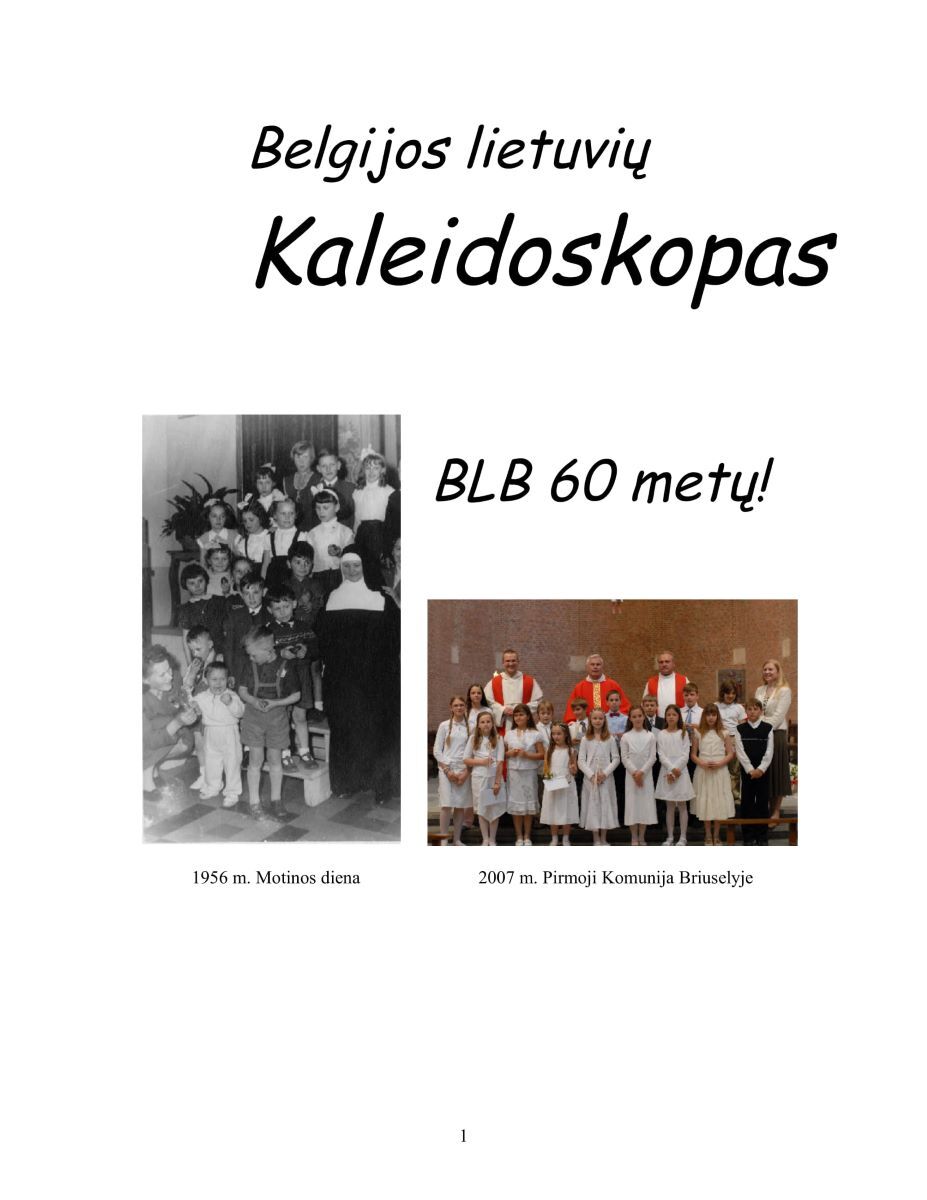
Cover of Kaleidoscope, 2007
Kaleidoscope (Belgium)
Kaleidoskopas
From 2003 to 2008 and once again in 2011, the Belgian Lithuanian Community published the annual publication, Kaleidoscope. Meant for community members, it was presented at year-end in appreciation of their financial and other support. The need and the idea for the magazine came from the community’s wish to preserve the stories and experiences of the older generation of Belgian Lithuanians, and to report on various events, issues and plans for the Community.
The scope of the publication was wide – from political news to community events and meetings. It included analysis of political life and events in Lithuania (especially Lithuania’s progress toward membership in the European Union and NATO), activities of the World Lithuanian Community, the Belgian Lithuanian Community, its plans and future. Aside from social and political issues, the publication included interviews with Belgian Lithuanians and their personal stories. The interviews renewed interest in the experiences of the older generation, their memories of the post-war period and various turning points in their lives. Kaleidoscope featured meetings with writers and artists, performances by Lithuanian musicians, festivals, articles about travel and exchange programs, even stereotypes encountered in Belgium.
For six years the editorial staff consisted of Community Board members Aurelija Norienė (president), Kristina Bradaitytė-Roekaerts, Regina Pauliukovaitė, Ramunė Januškaitė, Rita Gedvilaitė, Virginija Dvaranauskaitė, Rasa Vilčiauskaitė, Jurgita Žemaitytė and Kristina Jakavičiūtė. In 2009 a new board was elected and publication was suspended. It reappeared in 2011 with editor Karolina Štelmokaitė, but did not continue. K. Bradaitytė-Roekaerts considered this a natural phenomenon, with a new team having new goals and new ideas. People change, and this is very normal, she said. “They decided not to publish Kaleidoscope any longer, and perhaps there was no further need for it. We published it while it was needed, and now there are other means of sharing information.”
More about Kaleidoscope in an interview with K. Bradaitytė-Roekaerts. -
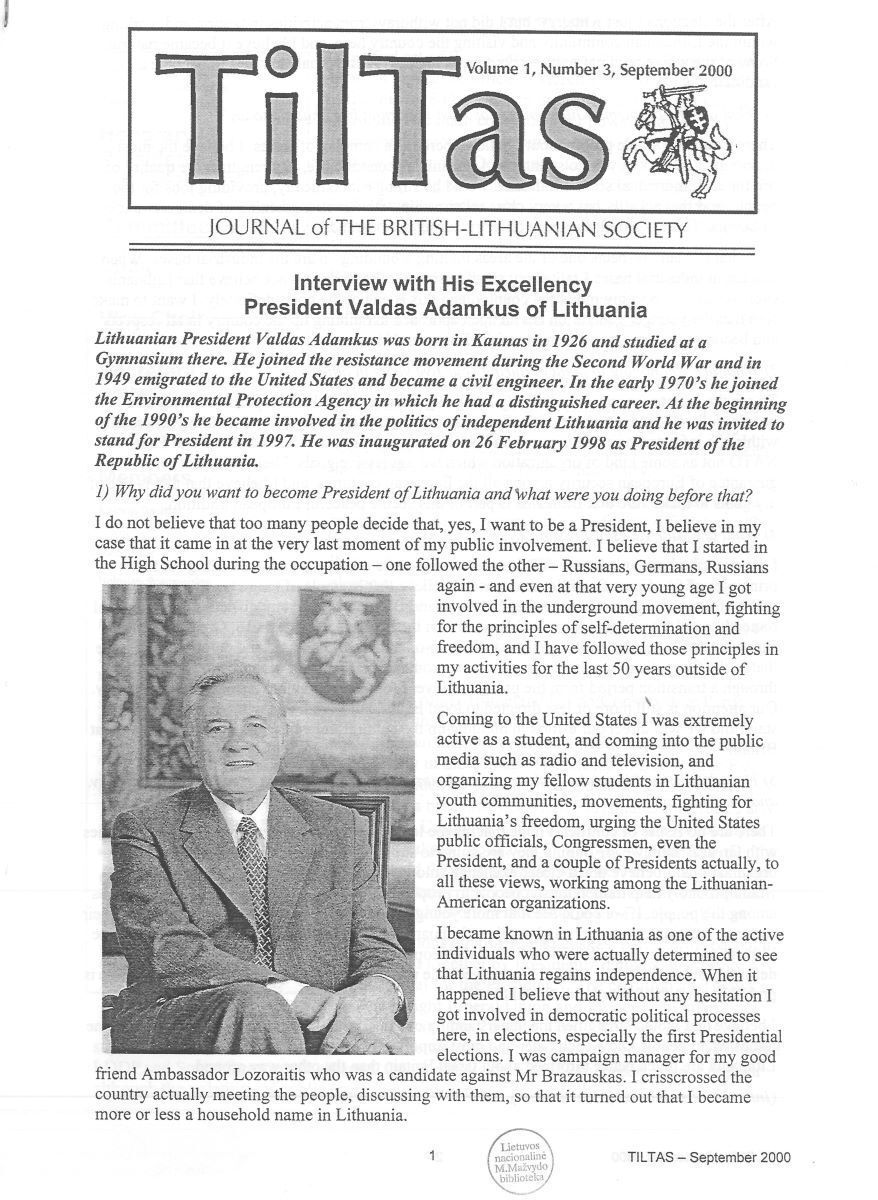
Cover of Bridge, No. 1 (3), 2000
Tiltas (Bridge) Journal of the British-Lithuanian Society
The British Lithuanian Society took root once the Lithuanian Embassy in London was reestablished after 1990. Its goal was to strengthen ties between the United Kingdom and Lithuania, in the fields of academics, politics and economics, both on an individual and organizational basis.
Bridge has been published as Tiltas Journal of the British-Lithuanian Society since 2000, to report on the Society’s activities as well as provide information about British Lithuanians, Lithuanian history, politics and culture. The first editor of Bridge was Dr. Maria Lenn. The current editor, Aleksas Vilčinskas, describes as his priorities the important Lithuanian anniversaries (e.g., March 11) and historic events in Lithuanian-British relations. Contributors to the publication are not paid.
At this time the majority of the Society’s members are British. Some Lithuanian members are from the displaced persons’ (DP) generation, and some immigrated after 1990. Editor A. Vilčinskas is a member of the DP generation, having arrived in the United Kingdom as a child. He is a retired construction engineer, and works for the publication pro bono, for the Fatherland.
Electronic publishing is not being used, as the majority of members like to receive print copies of the magazine, although the content may be sent by email. Publication costs are covered by the Society’s annual membership fees. Members receive the magazine free of charge.
The Society’s website. -
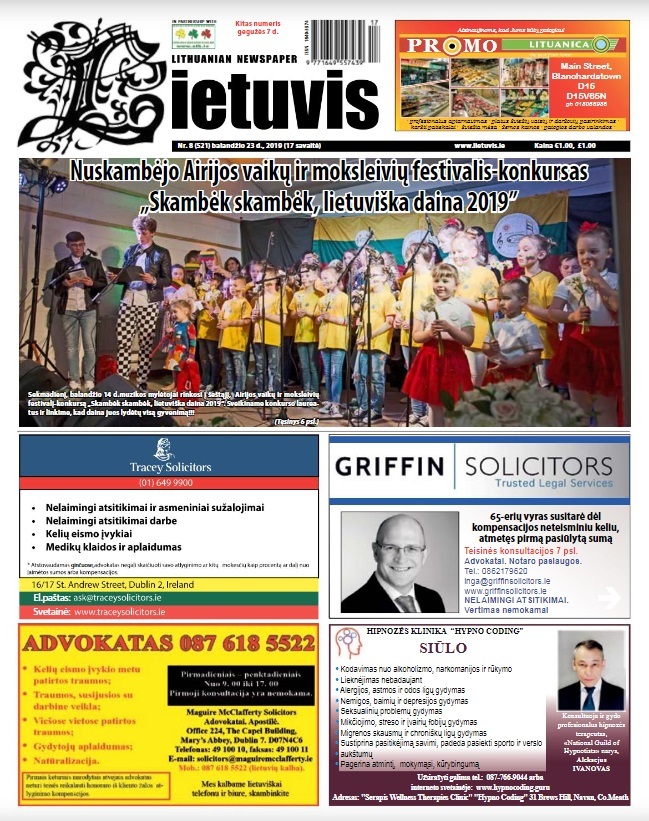
Front page of The Lithuanian, No. 8, April 23, 2019
The Lithuanian
Lietuvis
In 2004, when Lithuania joined the European Union, this newspaper appeared in Ireland, and is still published today by the company NewsInfo Media and Publications. At first the publication was meant for immigrants from Lithuania who had come to work and begin a new life there. The publishers’ purpose was to assist Lithuanians in settling in a new country by providing them with information about its laws and helping them integrate into a new community. The publishers noted that the newspaper was also intended for Lithuanians in Lithuania, whose children, parents, brothers, sisters, friends and relatives or acquaintances had left to try their luck in Ireland, and were thousands of kilometres away. “The Lithuanian brings us together –those of us here, and the ones left in the homeland.”
The Lithuanian was always connected to Irish Lithuanian events and the Lithuanian Embassy in Ireland. It reports on various meetings, community life and Lithuanians in Ireland, with current events from both countries, and provides legal advice, news about competitions, concerts, exhibitions in Ireland with information on ticket sales, ads and other relevant facts.
The newspaper has experienced high points and periods of stagnation as well. Although there were changes in editorial and support staff, and in scope, it always reached its readers in a timely manner and was quick to report on the latest news from both Lithuania and Ireland. The Lithuanian is published twice monthly, with 16 pages in colour, and costs one euro, or one pound sterling.
The Lithuanian also has a website in Lithuanian and English at www.lietuvis.ie, with a consistent readership of 5,000 per month and 15,000 new visitors. Most popular is the Facebook page, which has 8,000 followers catching up on the latest news from Ireland, Lithuania and the world.
All issues are available on the internet. -
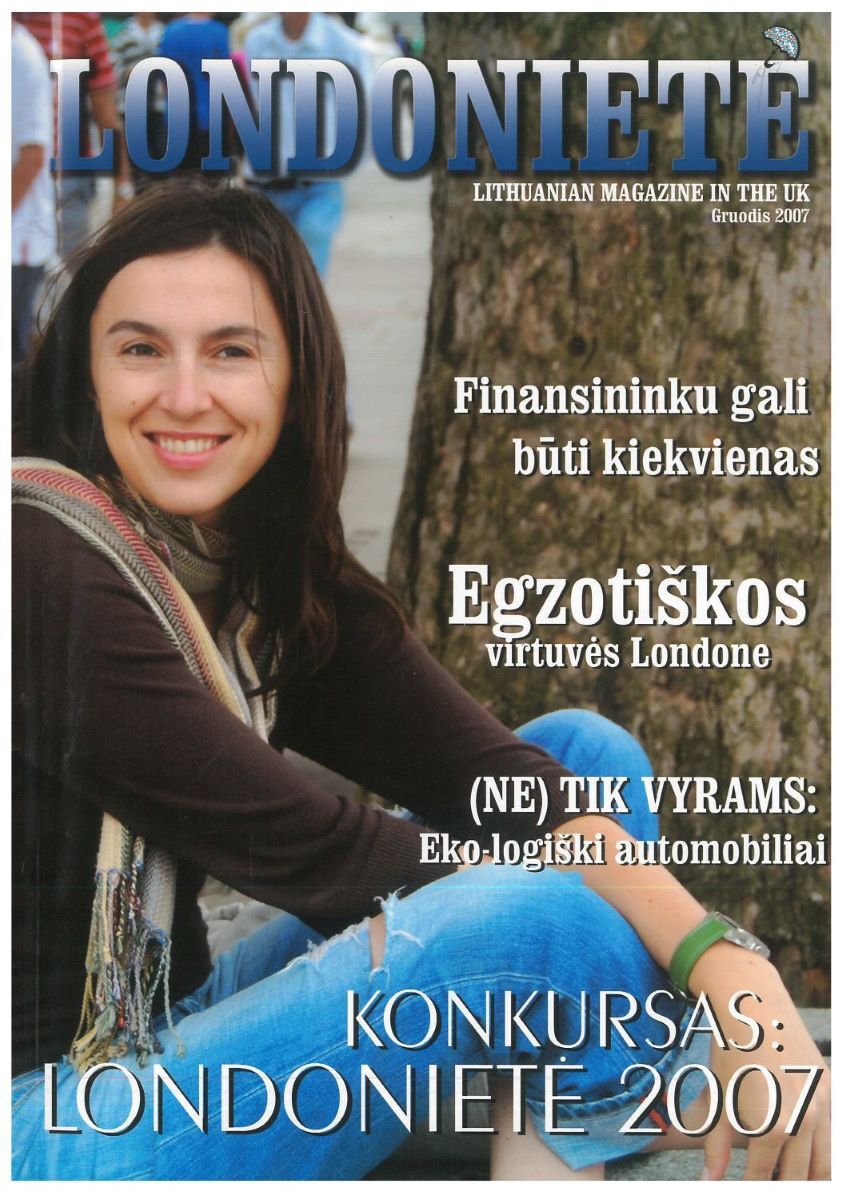
Front cover of the first issue, December, 2007
Ms. London
Londonietė: International Lithuanian Magazine
This magazine appeared in 2007. In the first issue, it was presented as follows: International Lithuanian Magazine Ms. London – the magazine for an ambitious lifestyle, for those wanting to “live better” physically and spiritually. According to publisher and editor D. Ilevičiūtė, her primary goal was to improve and foster the image of Lithuania and Lithuanians in the world, to encourage communication among Lithuanians, promote their success stories, businesses, and ideas, and to share interesting, useful and up-to-date information about the United Kingdom and Lithuania. The publication featured frank and compelling interviews with Lithuanians settling in England, articles on Lithuanian-UK relations, practical advice and fashion. This is a lifestyle magazine encompassing art, culture, work, entertainment and current events.
Over the years, its ideas and subject matter changed little, but now more content is offered in English. D. Ilevičiūtė maintains that there is no other magazine like it in the diaspora. She says that although this is not a community magazine, but a commercial publication, it promotes community spirit and it has certainly inspired and brought together a multitude of Lithuanians. The Ms. London team often hears from people who say they lived in the UK for years, but never socialized with Lithuanians. Encouraged by the profiles of interesting people they read in Ms. London, they were eager to join the Lithuanian community. Today the editor is assisted by Aistė Anusaitė-Daubaras, who joined the team a few years ago, and became co-owner of the magazine. A wide variety of professionals and creatives contribute to the success of this publication.
The magazine differs from others in this collection in that the website was the catalyst for the printed version of the magazine. It originated with www.londoniete.com, and became a print publication at a later time. The website has about 50,000 visitors per month and a following of 45,000 on social media. Particularly popular are the Announcement and Forum pages, which is typical of post-1990 media in the diaspora.

